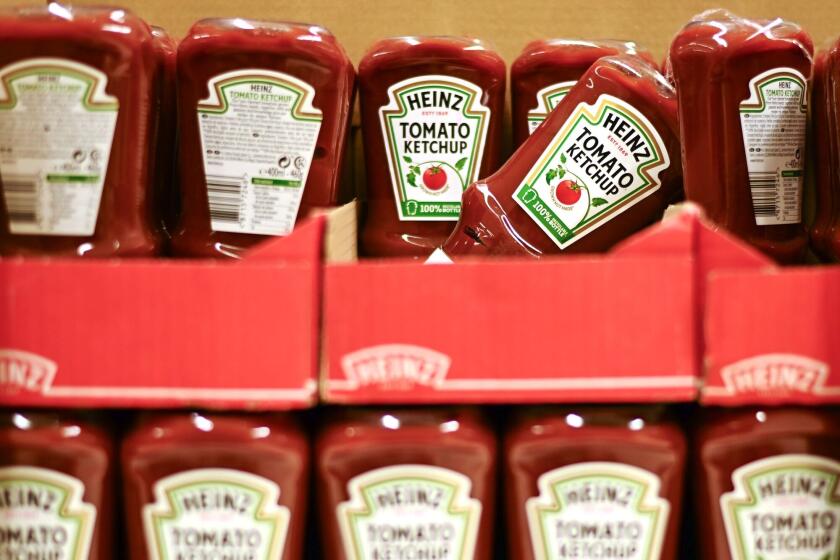The Olney Table : Lulu Cuisine
- Share via
Alice Waters is a friend of the family. So is Berkeley wine merchant Kermit Lynch, who imports the family’s wines, and, of course, cookbook author Richard Olney, who just wrote their book. They are among the very lucky with an open invitation to the vineyard lunches and suppers regularly held at the Provencal home of Lulu and Lucien Peyraud, proprietors of Domaine Tempier, the winery best known for its perfect Bandol rose.
Most of us can only dream of such meals. But the Peyrauds really seem to live the good life that most of us imagine for the residents of the Provence countryside. Boisterous, laughter-filled meals at long tables, overflowing with friends and platters of food are what Olney and photographer Gail Skoff present in “Lulu’s Provencal Table.”
Here is what Lynch wrote in his “Adventures on the Wine Route” about Lulu Peyraud:
“She speaks the way Colette writes, in a voice almost infantile, and with the same imaginative detail. . . . Her beauty was remarkable, that is certain, and men would stare at her from around the table, their heads full of several vintages of Domaine Tempier, concocting fantasies about this spirited Provencal beauty who kept placing delicious platters of food in front of their hungry faces, satisfying at least one of their appetites.”
Here is what Waters wrote in the introduction to the Olney book about the first time she met the Peyrauds in the mid-’70s:
“I’m not sure what they saw in me. I could barely speak passable French, and I had no credentials as a restaurateur or wine expert, but they embraced me and seated me at Lucien’s right hand, opposite Lulu. I remember the whole family was there and that Lucien, as he has done ever since, fed me the very best bits. . . . I tried to stutter in French my thanks and feelings of unworthiness, and Lulu leaned sympathetically toward me and said, ‘Don’t worry. I understand everything.’ ”
*
From the kitchen of Lulu Peyraud, as translated by Olney, here are a few good recipes from “Lulu’s Provencal Table.”
*
Save this recipe for a time when you can find fresh fava beans--it’s fantastic. Mint is the surprising herb that brightens the flavor. The soup is wonderful pureed--and that’s the way Lulu usually makes it, “because,” she told Olney, “Lucien (her husband) likes his soups pureed.” She confesses, however, that she likes the soup better when the beans are left whole--a possibility only when the favas are young and tender.
Olney suggests: “If the soup is not pureed, the beans should be fully developed (about the size of a thumbnail), the peels should still be green, not yellowing, and when each bean is peeled, the flesh should be a bright, clear green, tender enough to be easily cut into with one’s thumbnail. At a more advanced stage, while the peeled beans are still a fine green color but hardening and beginning to turn starchy, they can still make a delicious soup, but it is then better pureed.”
FRESH FAVA BEAN SOUP (Soupe aux Feves Fraiches)
1 quart water
Salt
1 large white onion, thinly sliced
1 large potato, peeled, quartered lengthwise and thinly sliced crosswise
2 pounds fava beans, peeled, each bean peeled
Freshly ground pepper
1 tablespoon finely chopped fresh mint leaves
2 tablespoons cold butter, diced
Bring water to boil in saucepan. Add salt to taste, onion and potato.
If fava beans are tender enough to be eaten raw, cook onion and potato at light boil, lid ajar, 30 minutes. Add fava beans, boil 1 to 2 minutes. Season to taste with pepper. Stir in mint and butter. Then serve.
If fava beans are hardening and beginning to turn starchy, cook onion and potato at light boil, lid ajar, 15 minutes. Add fava beans and cook another 15 to 20 minutes, until all vegetables are puree-tender. Pass mixture through vegetable mill. Reheat. Season to taste with pepper to taste. Stir in mint and butter. Then serve. Makes 4 servings.
Each serving contains about:
857 calories; 164 mg sodium; 16 mg cholesterol; 9 grams fat; 140 grams carbohydrates; 60 grams protein; 7.03 grams fiber.
*
A simple, wonderful, rustic dish. Olney writes: “Pissaladiere derives from the word ‘pissala,’ a puree of tiny salted anchovy and sardine fry that was, in Nice, traditionally mixed with the cooked onions before spreading them onto rolled-out bread dough. Today, nearly everyone uses anchovies instead of pissala for the confection of pissaladiere; Lulu prefers short crust to bread dough. She uses large white summer onions, very sweet with a high water content. Nicoise olives are small ripe and semi-ripe (mixed black, brown and violet) olives preserved in an aromatic brine; they are now commonly available on the American market.”
ONION TART (Pissaladiere)
Tart Pastry Dough
1/4 cup olive oil
2 pounds white onions, finely sliced
Salt
Freshly ground pepper
8 salted anchovies, rinsed and filleted, or 16 fillets
1/2 cup Nicoise olives
Make Tart Pastry Dough and refrigerate at least 1 hour.
Warm 2 tablespoons olive oil in large earthenware casserole or heavy saute pan. Add onions. Season to taste with salt. Cook, covered over very low heat, stirring occasionally with wooden spoon until onions are soft enough to form semi-puree, about 1 hour. Remove lid and continue to cook until much of liquid has evaporated. Onions should remain absolutely uncolored. Season to taste with pepper.
With palm of hand, flatten ball of Tart Pastry Dough on generously floured marble slab or other work surface. Sprinkle plenty of flour over dough and roll out to thickness of approximately 1/8 inch. Roll dough up on rolling pin and unroll onto large baking sheet. Roll up edges and crimp, either with thumb, dipped repeatedly in flour, or with fork tines. Spread onion puree evenly over pastry, press anchovy fillets into place in simple latticework or wheel-spoke design and push olives into puree to complete design.
Drizzle remaining 2 tablespoons olive oil over surface. Bake at 375 degrees until edges of pastry are golden and crisp, about 30 minutes. Serve hot or tepid. Cut into small wedges or squares as appetizers, or in large wedges as first course. Makes 8 servings.
Each serving contains about:
299 calories; 550 mg sodium; 42 mg cholesterol; 24 grams fat; 19 grams carbohydrates; 4 grams protein; 0.76 gram fiber.
Tart Pastry Dough
1 cup flour
Salt
10 tablespoons cold butter, diced
1/4 cup cold water, about
Sift flour and salt into mixing bowl. Add diced butter. Crumble flour and butter together, lightly and rapidly, picking up portions and rubbing loosely between thumb and fingertips. Do not overwork pastry.
Gather together with fork and little cold water into ball shape. Wrap in plastic wrap and refrigerate at least 1 hour before rolling out.
*
Of this amazing gateau, Olney says this: “Dictionaries translate ‘gateau’ as ‘cake.’ This is not a cake. Lulu says, ‘Well, it is really a galette of sorts. . . .’ The dictionaries give excessively vague and various definitions for galette. In fact, a galette is something round, usually thin and compact, and usually, but not necessarily, baked. This walnut gateau is, in any case, unleavened, dense, moist and delicious. Lulu likes it thin and, for that reason, uses two round 10-inch cake tins; a single 12-inch-diameter tin will do as well. Tempier vin cuit usually accompanies it, but a Sauternes or a late-harvest Gewurztraminer will also serve well.”
WALNUT GATEAU (Gateau aux Noix)
1/2 cup butter, softened at room temperature, plus extra for pans
1 1/2 cups sugar
Salt
5 eggs, at room temperature
1/2 pound shelled walnuts, pulverized in blender (handful at time) or in food processor
1/4 cup peeled and finely grated carrot
2/3 cup flour
Put butter in mixing bowl. Add sugar and salt. Work to creamy consistency with wooden spoon or rubber spatula. Beat in eggs, 1 at time. Stir in pulverized walnuts and grated carrot. Then gradually sift in flour, stirring briskly, then beating.
Butter 2 (10-inch) cake pans. Butter 2 circles parchment paper cut to size of pans and press unbuttered sides to bottoms of pans. Pour in batter.
Bake at 325 degrees until skewer, pierced in center of each gateau, comes out clean and dry, about 40 minutes. Cool gateau in pans. Loosen gateau from sides of pans with knife tip. Unmold onto plates and peel off parchment paper. Serve tepid or at room temperature. Makes 12 to 14 servings.
Each of 12 servings contains about:
341 calories; 131 mg sodium; 108 mg cholesterol; 21 grams fat; 33 grams carbohydrates; 6 grams protein; 0.9 gram fiber.
* Bowl in fava bean soup photo from Bristol Farms Cook ‘n’ Things, South Pasadena.
More to Read
Eat your way across L.A.
Get our weekly Tasting Notes newsletter for reviews, news and more.
You may occasionally receive promotional content from the Los Angeles Times.











